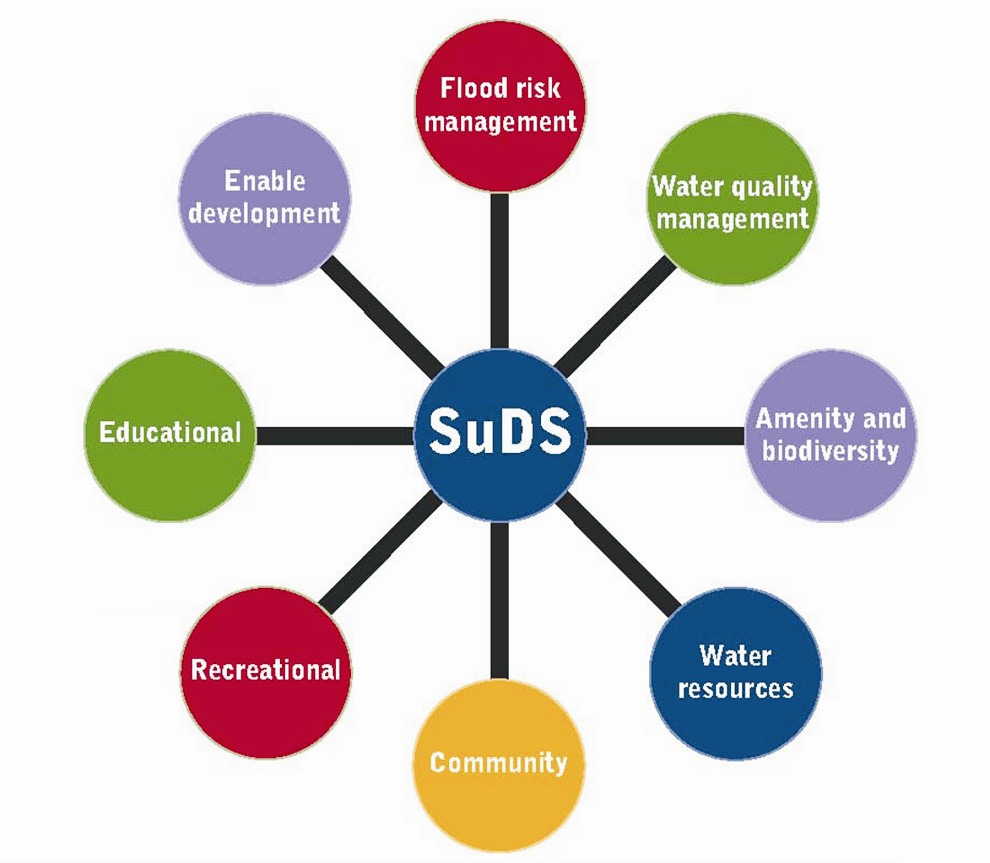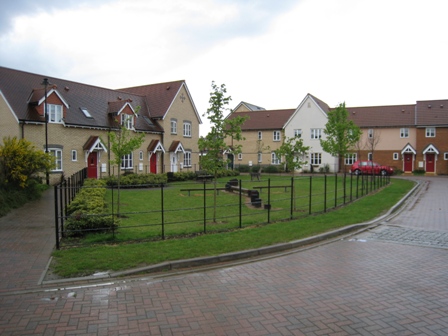

SuDS-related links
Keeping ahead
with SuDS
Attend SuDS training to keep ahead of the competition and to deliver innovative solutions in line with recognised good practice.
home > using SuDS > benefits of SuDS
There is a growing acceptance that we need to have a more sustainable approach to managing surface water. Sustainable drainage systems (SuDS) mimic natural drainage processes to reduce the effect on the quality and quantity of runoff from developments and provide amenity and biodiversity benefits. When specifying SuDS, early consideration of potential benefits and opportunities will help deliver the best results.
Schemes providing many of the benefits depicted in figure 1 below.

Figure: 1 Benefits of SuDS
Development often alters natural drainage by replacing free draining ground with impermeable surfaces, gulleys, pipes, sewers and channels. Also, it can remove vegetation and compact the ground. These changes increase the total volume and flow of runoff and may make areas more susceptible to flooding locally but also exacerbate river flooding.
Our climate is changing, and recent research on climate change suggests that:
Drainage systems need to adapt to and mange extreme events including flooding and periods of drought, while reducing our carbon emissions. SuDS schemes can be designed to slow water down (attenuate) before it enters the watercourse, provide areas for water storage in natural contours, and can be used to allow water to soak (infiltrate) into the ground or evaporated from surface water and transpired from vegetation (known as evapotranspiration).
Our activities lead to numerous pollutants (such as oil, sediments, fertilisers, pesticides, animal waste and litter) that can cause diffuse pollution and adversely affect the environment, which is not managed by traditional piped drainage. Pollutants or contaminants can be washed into sewers and eventually watercourses through surface water runoff making it difficult to comply with water quality legislation.
Some SuDS components provide water quality improvements by reducing sediment and contaminants from runoff either through settlement or biological breakdown of pollutants.
There is increasing pressure on planners and developers to deliver green infrastructure, with many local authorities developing green infrastruture plans. SuDS can improve a development by creating habitats that encourage biodiversity and simultaneously provide open space.
SuDS components (like ponds and wetlands) provide an array of amenity, recreational and biodiversity benefits. However, they will only fulfil their ecological potential, if their design criteria consider ecology, flood risk and water quality management together. SuDS provide opportunities to create visually attractive green (vegetated and landscaped) and blue (water) corridors in developments connecting people to water.
As challenges of climate change become more apparent the consideration of the water cycle and approaches to adaptation will become more important. In areas that require water cycle studies, where the effects of development on the water cycle have to be managed, SuDS are often required. Some SuDS components that soak water into the ground can recharge underground aquifers (where there is no risk of polluting the aquifer). More specifically SuDS can capture, or harvest rainwater that can be used for functions that do not require treated water from the mains (flushing toilets, irrigation etc). This may contribute to water efficiency this is also a good approach to scoring highly in the Code for Sustainable Homes (CLG, 2006).
National and regional planning policies encourage the design of attractive public open space and the development of social cohesion to improve the quality of life and create better communities. Well designed SuDS can incorporate many of these aspects that create better places to live, work and play. SuDS deliver value and benefits for the community often in highly urbanised areas improving local quality of life by:
|
 |
By introducing water to the urban environment the planning process provides the opportunity to bring SuDS into the public arena, addressing the aspirations of the public for a better, cleaner and greener urban environment.
SuDS can deliver recreational benefits through the dual use of components and facilities such as using attenuation and storage areas and overland conveyance routes for play and/or sports areas. Also, multifunctional use of SuDS components can have other benefits such as the incorporation of recreational open space into a development that otherwise may be deemed impracticable by a developer.
In addition to improvements to the visual appearance of a development, many SuDS components have been used for recreational and educational purposes with schemes located in school grounds. The Matchborough School includes SuDS to manage surface water that also provides an invaluable learning resource about water click here for the matchborough case study.
Delivery of SuDS can enable the granting of planning permission as sustainable drainage is encouraged through national planning policy. The Environment Agency expects SuDS to be incorporated into new developments. SuDS can provide savings on the overall construction and maintenance of drainage schemes. The SuDS scheme at Lamb Drove, Cambourne in Cambridgeshire gave a 10% saving on design and capital costs to traditional drainage. This saving could have increased with effective preapplication discussions click here for the Lamb Drove case study.
The use of SuDS and resultant improvements in visual attractiveness of a development has been proven to increase house values by 10% to 20%. Also, sustainable drainage can be integrated into strategies for public open space and green infrastructure within developments.